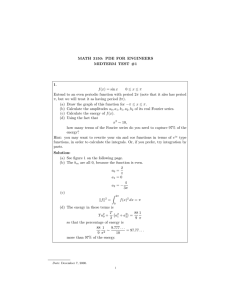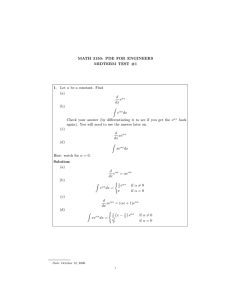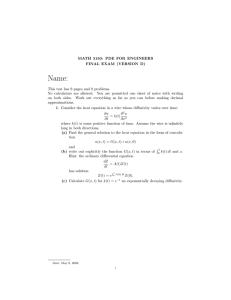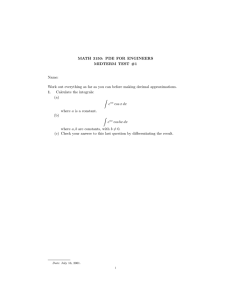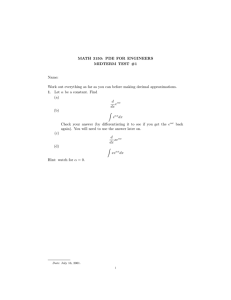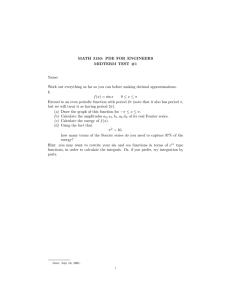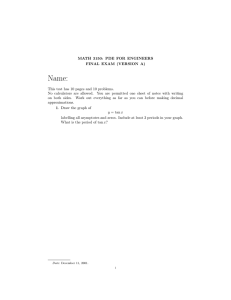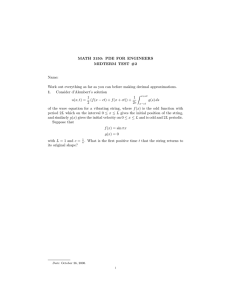MATH 3150: PDE FOR ENGINEERS FINAL EXAM (VERSION D)
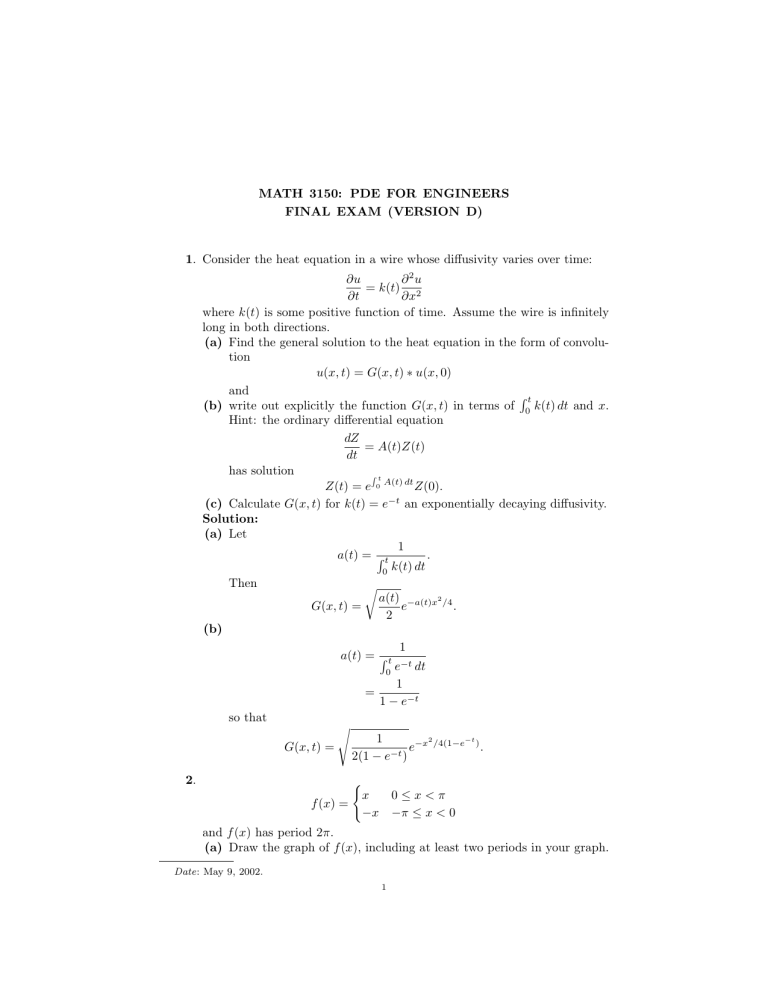
MATH 3150: PDE FOR ENGINEERS
FINAL EXAM (VERSION D)
1 . Consider the heat equation in a wire whose diffusivity varies over time:
∂u
∂t
∂ 2 u
= k ( t )
∂x 2 where k ( t ) is some positive function of time. Assume the wire is infinitely long in both directions.
(a) Find the general solution to the heat equation in the form of convolution u ( x, t ) = G ( x, t ) ∗ u ( x, 0) and
(b) write out explicitly the function G ( x, t ) in terms of
Hint: the ordinary differential equation
R t k ( t ) dt and x .
0 dZ
= A ( t ) Z ( t ) dt has solution
Z ( t ) = e
R t
0
A ( t ) dt
Z (0) .
(c) Calculate G ( x, t ) for k ( t ) = e
− t an exponentially decaying diffusivity.
Solution:
(a) Let a ( t ) =
1
R t
0 k ( t ) dt
.
Then
G ( x, t ) = r a ( t ) e
− a ( t ) x
2
/ 4
.
2
(b) a ( t ) =
1
R t
0 e − t dt
1
=
1 − e − t so that
G ( x, t ) = s
1
2(1 − e − t ) e
− x
2
/ 4(1 − e
− t
)
.
2 .
f ( x ) =
( x 0 ≤ x < π
− x − π ≤ x < 0 and f ( x ) has period 2 π .
(a) Draw the graph of f ( x ), including at least two periods in your graph.
Date : May 9, 2002.
1
2 MATH 3150: PDE FOR ENGINEERS FINAL EXAM (VERSION D)
(b) Calculate the real Fourier amplitudes a m and b m of f ( x ). Hint:
Z x cos x dx = cos x + x sin x .
(c) Find the energy of f ( x ).
(d) In the form of a fraction, find the total percentage of energy contained among the amplitudes a
0
, a
1
, b
1
, a
2
, b
2
. Do not use any decimal approximations.
(e) Show that over 95% of the energy is stored among the amplitudes a
0
, a
1
, b
1
, a
2
, b
2
. Hint: π 4
Solution:
∼ 97 .
(a) See figure 2a on the facing page.
(b) Because the function is even, b m
= 0.
a
0
= f rac 1 L
Z
L
0 f ( x ) dx
1 Z
π
= x dx
=
π
π
.
2
0
(c) a m
=
=
2 Z
0
L
πmx
L
2
0
Z
π f ( x ) cos
L x cos ( mx ) dx
π
=
=
2
(( − 1) m
πm 2
(
− 4
πm 2 if
− m
1) is odd
0 if m is even dx so a
2 k +2
= 0 while a
2 k +1
4
= −
π (2 k + 1) 2
.
Thus f ( x ) =
π
−
2
4
π
1 cos( x ) +
3 2 cos(3 x ) +
1
5 2 cos(5 x ) + . . .
.
k f k 2
Z
T / 2
= f ( x )
2 dx
= 2
− T / 2
Z
π x
2 dx
0
= 2
π 3
.
3
MATH 3150: PDE FOR ENGINEERS FINAL EXAM (VERSION D) 3
3
2.5
2
1.5
0.5
1
–8 –6 –4 –2
0
2 4 x
6 8
4 MATH 3150: PDE FOR ENGINEERS FINAL EXAM (VERSION D)
(d)
T a
2
0
+
T
2 a
2
1
+ b k f k 2
2
1
+ a
2
2
+ b
2
2
=
2 π ( π/ 2)
2
+ π
16
π 2
(1 + 0 + 0 + 0)
2 π 3 / 3
=
π 3 / 2 +
2 π 3 / 3
16
π
=
3
4
+
24
π 4
(e)
3
4
+
24
π 4
∼
>
=
3
+
4
3
+
4
75
100
99
24
97
24
100
24
+
100
=
100
= 99% .
3 . True or false: the Fourier transform of the function f ( x ) =
( e
−| x |
0 if − 1 ≤ otherwise x ≤ 1 is f
ˆ
( ω ) =
1
1 + ω 2
.
Solution: False.
4 . Calculate the kernel K ( x, t ) for the heat equation with convection
∂u
∂t
= k
∂u
∂x
+ c
2
∂ 2 u
∂x 2 where c and k are constants, so that the solution of the heat equation with convection will be u ( x, t ) = √
1
2 π
Z
∞
−∞ u ( s, 0) K ( x − s, t ) ds.
It might help to know the integral:
√
1
2 π
Z
∞
−∞ e
− ap
2 e ipx dp = √
1
2 a e
− x
2
/ 4 a where a is any constant.
Solution:
∂ ˆ
= kip − c
2 p
2
∂t so that
ˆ ( p, t ) = e t ( kip − c
2 p
2
)
ˆ ( p, 0) and u ( x, t ) = F
− 1 e t ( kip − c
2 p
2
) ∗ u ( x, 0) .
MATH 3150: PDE FOR ENGINEERS FINAL EXAM (VERSION D) 5
So
K ( x, t ) = F − 1 e t ( kip − c
2 p
2
)
= √
1
2 π
= √
1
2 π
Z
∞ dp
−∞
Z
∞ e
− tc
2 p
2 e ip ( x + tk ) dp
−∞ e
− tc
2 p
2 e tkip e ipx
= √
1
2 tc 2 e
− ( x + tk )
2
/ 4 tc
2
.
5 . Expand the function f ( x ) = arctan x in a Taylor expansion to four terms about x = 0. Hint: f
0
( x ) =
1
1 + x 2
= 1 − x
2
+ x
4
− x
6
+ . . .
(a geometric series), and the Taylor expansion is f ( x ) = f (0) + f
0
(0) x +
1!
f
00
(0) x
2
2!
+ · · ·
Solution: f ( x ) = x − x 3
+
3 x 5
−
5 x 7
7
+ . . . .
6 . Take a disk of unit radius and heat the right half of the edge of the disk to 1 o and the left half of the edge to 0 o . Let the disk sit with these temperatures on its edges for a long time, until it reaches a steady state. Center the disk at origin of coordinates. Draw a graph of u as a function of radius r at
θ = 0, from r = 0 to r = 1, clearly labelling the maximum and minimum values on the vertical axis. Hint: recall that if we write the temperature of the edge of the disk as f ( θ ) , and write the Fourier amplitudes of f ( θ ) as a b a
0
= m m
=
=
1 Z
− π
π f ( θ ) dθ
2 π
1
− π
Z
π f ( θ ) cos( mθ ) dθ
π
1 Z
π f ( θ ) sin( mθ ) dθ
π
− π then the steady state temperature inside the plate, in polar coordinates, is u ( r, θ ) = a
0
+
∞
X r m
( a m cos ( mθ ) + b m sin ( mθ )) m =1
Hint: now compare with the last problem.
Solution: The function is f ( θ ) =
(
1 if − π/ 2 < θ < π/ 2
0 otherwise.
6 MATH 3150: PDE FOR ENGINEERS FINAL EXAM (VERSION D)
It Fourier coefficients are a a
0
=
1 m
=
2
1 Z
π/ 2 cos( mθ ) dθ
π
− π/ 2
=
2
πm
1
if m = 1 + 4 k, k = 0 , 1 , 2 , . . .
− 1 if m = 3 + 4 k, k = 0 , 1 , 2 , . . .
0 if m is even.
b m
= 0
(since f ( θ ) is even). Thus u ( r, θ ) =
1
2
2
+
π
∞
X k =0 r
1+4 k
1
1 + 4 k cos ((1 + 4 k ) θ ) − r
3+4 k
1
3 + 4 k cos ((3 + 4 k ) θ ) .
Plugging in θ = 0 gives u ( r, θ ) =
1
2
+
2
π r − r
3
3
=
1
2
+
2
π arctan( r ) .
+ r 5
5
− r 7
7
+ . . .
The graph is drawn in figure 6 on the next page.
7 . Take a function f ( x ) with period T and form the function g ( x ) = f ( ax ) for some constant a . The period of g ( x ) is
(a) aT
(b) T /a
(c) 2 π
(d) 2 πa/T
(e) none of the above.
The energy of g ( x ) is related to the energy of f ( x ) by
(a) E ( g ) = E ( f )
(b) E ( g ) = a 2 E ( f )
(c) E ( g ) = aE ( f )
(d) E ( g ) =
1 a
1
E ( f )
(e) E ( g ) = a 2
E ( f )
(f ) none of the above.
Solution: ( b ) and ( d ).
8 .
(a) Suppose that u ( x, t ) satisfies the wave equation
∂ 2 u
∂t 2
= c
2
∂ 2 u
∂x 2 with u = 0 at x = 0 and x = L at all times t . Why is it true that
∂
∂x
∂u
∂x
∂u
∂t
∂ 2 u ∂u
=
∂x 2 ∂t
+
∂u
∂x
∂ 2 u
∂x∂t
?
0.8
u
0.6
0.4
0.2
1
MATH 3150: PDE FOR ENGINEERS FINAL EXAM (VERSION D) 7
0
0.2
0.4
r
0.6
0.8
1
8 MATH 3150: PDE FOR ENGINEERS FINAL EXAM (VERSION D)
(b) Show that u ( x, t ) has constant (in time) energy, where the energy of u ( x, t ) is defined to be
1 Z
L
E =
2
0
∂u
∂t
2
+ c
2
∂u
∂x
2 !
dx.
Hint: differentiate in t , use the wave equation to get rid of
∂
2 u
∂t 2
. Do not use any Fourier series or transforms. Do not separate variables.
Warning: this notion of energy is different from the one we studied for
Fourier series.
Solution:
(a) The chain rule for partial derivatives.
(b) dE
= dt d 1 dt 2
Z
L
0
∂u
∂t
2
+ c
2
∂u
∂x
2 !
dx
1 Z
L
=
2
Z
L
0
=
0
2
∂u
∂t
∂ 2
∂t
∂u c
2
∂t
∂ 2 u
∂x 2 u
2
+ 2 c
2
∂u
∂x
∂ 2 u
∂t∂x
+ c
2
∂u
∂x
∂ 2 u
∂t∂x dx dx
= c
2
Z
L
0
∂
∂x
∂u
∂x
∂u
∂t dx x = L
∂u ∂u
= c
2
∂x ∂t x =0
= 0 because u = 0 at x = 0 and x = L all the time, and so its rate of change is ∂u
∂t
= 0 there too.
